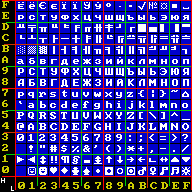Related Research Articles
ISO/IEC 8859-11:2001, Information technology — 8-bit single-byte coded graphic character sets — Part 11: Latin/Thai alphabet, is part of the ISO/IEC 8859 series of ASCII-based standard character encodings, first edition published in 2001. It is informally referred to as Latin/Thai. It is nearly identical to the national Thai standard TIS-620 (1990). The sole difference is that ISO/IEC 8859-11 allocates non-breaking space to code 0xA0, while TIS-620 leaves it undefined.
Windows-1258 is a code page used in Microsoft Windows to represent Vietnamese texts. It makes use of combining diacritical marks.

Code page 855 is a code page used under DOS to write Cyrillic script.

Code page 866 is a code page used under DOS and OS/2 in Russia to write Cyrillic script. It is based on the "alternative code page" developed in 1984 in IHNA AS USSR and published in 1986 by a research group at the Academy of Science of the USSR. The code page was widely used during the DOS era because it preserves all of the pseudographic symbols of code page 437 and maintains alphabetic order of Cyrillic letters. Initially, this encoding was only available in the Russian version of MS-DOS 4.01 (1990) and since MS-DOS 6.22 in any language version.
Windows code page 1253, commonly known by its IANA-registered name Windows-1253 or abbreviated as cp1253, is a Microsoft Windows code page used to write modern Greek. It is not capable of supporting the older polytonic Greek.
Windows-1255 is a code page used under Microsoft Windows to write Hebrew. It is an almost compatible superset of ISO-8859-8 – most of the symbols are in the same positions, but Windows-1255 adds vowel-points and other signs in lower positions.
Mac OS Cyrillic is a character encoding used on Apple Macintosh computers to represent texts in the Cyrillic script.
Mac OS Central European is a character encoding used on Apple Macintosh computers to represent texts in Central European and Southeastern European languages that use the Latin script. This encoding is also known as Code Page 10029. IBM assigns code page/CCSID 1282 to this encoding. This codepage contains diacritical letters that ISO 8859-2 does not have, and vice versa.
Code page 865 is a code page used under DOS in Denmark and Norway to write Nordic languages.
Code page 860 is a code page used under DOS in Portugal to write Portuguese and it is also suitable to write Spanish and Italian. In Brazil, however, the most widespread codepage – and that which DOS in Brazilian portuguese used by default – was code page 850.
Code page 857 is a code page used under DOS in Turkey to write Turkish.

Code page 737 is a code page used under DOS to write the Greek language. It was much more popular than code page 869 although it lacks the letters ΐ and ΰ.
Code page 869 is a code page used under DOS to write Greek and may also be used to get Greek letters for other uses such as math. It is also called DOS Greek 2. It was designed to include all characters from ISO 8859-7.
Code page 862 is a code page used under DOS in Israel for Hebrew.
Mac OS Icelandic is an obsolete character encoding that was used in Apple Macintosh computers to represent Icelandic text. It is largely identical to Mac OS Roman, except for the Icelandic special characters Ý, Þ and Ð which have replaced typography characters.
Code page 851 is a code page used under DOS to write Greek language although it lacks the letters Ϊ and Ϋ. It covers the German language as well. It also covers some accented letters of the French language, but it lacks most of the accented capital letters required for French. It is also called MS-DOS Greek 1.
Code page 856, is a code page used under DOS for Hebrew in Israel.
Each character is shown with its equivalent Unicode code point. Only the second half of the table is shown, the first half being the same as ASCII.
Mac OS Romanian is a character encoding used on Apple Macintosh computers to represent the Romanian language. It is a derivative of Mac OS Roman.
Mac OS Croatian is a character encoding used on Apple Macintosh computers to represent Gaj's Latin alphabet. It is a derivative of Mac OS Roman. The three digraphs, Dž, Lj, and Nj, are not encoded.
References
- 1 2 "Code page 1280 information document". Archived from the original on 2016-03-03.
- ↑ "CCSID 1280 information document". Archived from the original on 2014-11-29.
- ↑ "Code Page 10006 MacGreek". Developing International Software. Microsoft. 6 February 2008. Retrieved 27 Mar 2014.
- ↑ Apple Computer. "GREEK.TXT" (TXT). The Unicode Consortium. Retrieved 27 Mar 2014.
- ↑ Code Page CPGID 01280 (pdf) (PDF), IBM
- ↑ Code Page CPGID 01280 (txt), IBM
- ↑ International Components for Unicode (ICU), macos-6_2-10.4.ucm, 2005-09-26